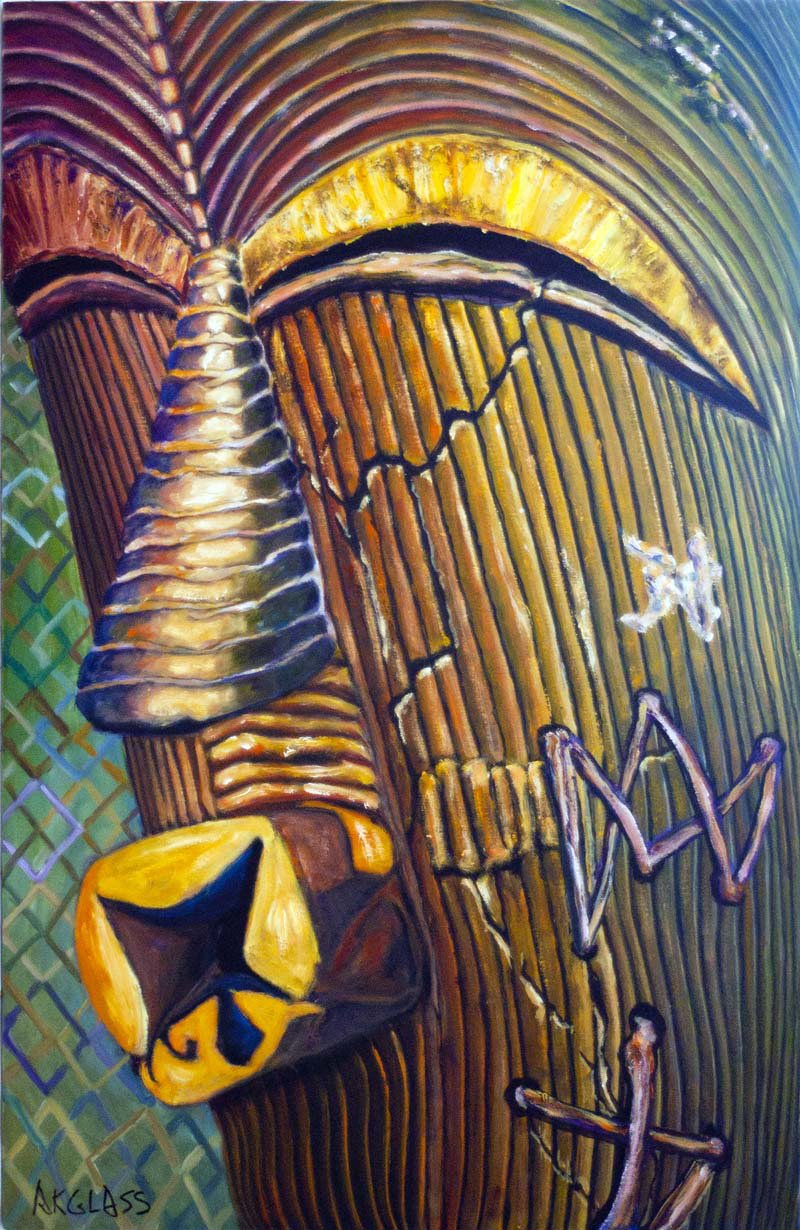 Image 1 of 1
Image 1 of 1


Songye Female Kifwebe Mask
Painting of an African Mask
Unframed Oil on Canvas Original
40" x 26"
Songye People, Kifwebe Brotherhood, Democratic Republic of Congo
Bwadi bra Kifwebe is a secret society of masked men. In the community, these men were known for their use of magic (Buki or Buchi) and sorcery (Masende). Buki and Masende magic differ from witchcraft; these types of magic are inherited or obtained either by will or unconsciously. Witchcraft, in contrast, can be obtained through initiation and the appropriate use of magical ingredients. In order to become a member of the Bwadi bra Kifwebe, applicants must undergo an initiation process. During this process, initiates must learn and identify secret esoteric language. They must undergo a radical and often violent experience to become less fearful of the unknown and to learn their roles within the Bwadi bra Kifwebe society.
Some of the responsibilities of the Bwadi bra Kifwebe include regulating and maintaining political order and balance between the chief and his communities. They maintain balance within the community by conducting masquerades, rituals, and rites such as initiation rituals, circumcisions, and funerals.
The overall appearance of a masquerader varies depending on the dancer, the type of ceremony, and the spirit being evoked. Typically, masqueraders wear a wooden mask and are covered head to toe in flowing black raffia fibers made from the bark or roots of trees. Their arms, bodies, and legs are covered with raffia netting, with goat skins fastened around their waists. The dancers are male, and the complexity of their costume varies based on their status within the community. When the dancer wears a male mask, his movements are aggressive and unstable; when wearing a female mask, his movements are gentle and controlled. The dances of the Kifwebe dancers are meant to encourage social conformity within the community, showing people how one should behave in their society.
One in a series of eleven paintings inspired by tribal African masks from museums and private collections. They were in use during the 19th and early 20th centuries.
Painting of an African Mask
Unframed Oil on Canvas Original
40" x 26"
Songye People, Kifwebe Brotherhood, Democratic Republic of Congo
Bwadi bra Kifwebe is a secret society of masked men. In the community, these men were known for their use of magic (Buki or Buchi) and sorcery (Masende). Buki and Masende magic differ from witchcraft; these types of magic are inherited or obtained either by will or unconsciously. Witchcraft, in contrast, can be obtained through initiation and the appropriate use of magical ingredients. In order to become a member of the Bwadi bra Kifwebe, applicants must undergo an initiation process. During this process, initiates must learn and identify secret esoteric language. They must undergo a radical and often violent experience to become less fearful of the unknown and to learn their roles within the Bwadi bra Kifwebe society.
Some of the responsibilities of the Bwadi bra Kifwebe include regulating and maintaining political order and balance between the chief and his communities. They maintain balance within the community by conducting masquerades, rituals, and rites such as initiation rituals, circumcisions, and funerals.
The overall appearance of a masquerader varies depending on the dancer, the type of ceremony, and the spirit being evoked. Typically, masqueraders wear a wooden mask and are covered head to toe in flowing black raffia fibers made from the bark or roots of trees. Their arms, bodies, and legs are covered with raffia netting, with goat skins fastened around their waists. The dancers are male, and the complexity of their costume varies based on their status within the community. When the dancer wears a male mask, his movements are aggressive and unstable; when wearing a female mask, his movements are gentle and controlled. The dances of the Kifwebe dancers are meant to encourage social conformity within the community, showing people how one should behave in their society.
One in a series of eleven paintings inspired by tribal African masks from museums and private collections. They were in use during the 19th and early 20th centuries.
